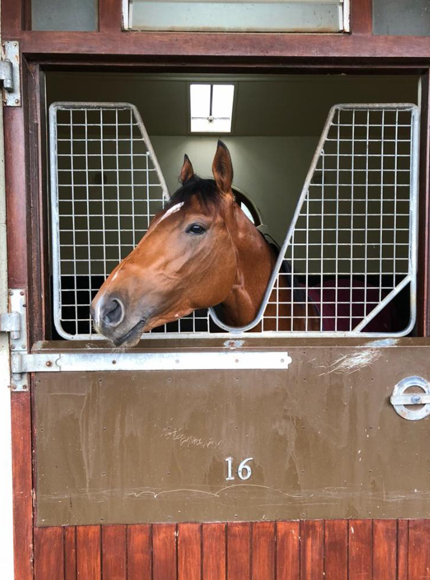3 minute read
Looking at the hot favourite for the Derby, in the context of the Triple Crown, Jamie Lynch runs down the various elements which speak in favour of Saxon Warrior.

Dr Becker, after examining Grandad: ‘Don’t worry, he’s got legs like Nijinsky.’
Del, puzzled: ‘But Nijinsky’s a racehorse.’
Rodney: ‘No, Del, he means the Russian ballet dancer.’
Dr Becker: ‘No I don’t.’
Everybody got the reference, because everybody, in the ‘eighties, knew of the racehorse. In Lester Piggott’s words, Nijinsky had ‘lost his fire’ by the time of his defeats in the Arc and Champion Stakes at the end of his three-year-old season, in 1970, but by then he was already immortalised, due partly to his series of performances but more so to his performance in the series.
Success in the Triple Crown series defined Nijinsky and said more about him than victory in any single race could. There is a statue of Nijinsky at the entrance to Ballydoyle, where he was trained by Aidan O’Brien’s predecessor Vincent O’Brien, and we’re at a point where a sculptor may be measuring up Saxon Warrior, because Saxon Warrior is measuring up on the track to Nijinsky as an unbeaten Guineas winner heading to the Derby amid mounting speculation of the Triple Crown being resurrected.
The Triple Crown represents the highest ideals of horseracing, still so in America, less so in Britain nowadays. For a shared title, and a shared target, of determining a conclusive champion, the series on either side of the Atlantic bear little resemblance, crammed into five weeks in the USA and spaced out over a far wider range of trip and time - as much as five months - in the UK, the Triple Crown in both instances a victim of its conservatism.
In a week’s time, when Justify makes his jump for history in the Belmont, having completed the hop and skip elements, standing in his way, amongst others, will be Hofburg and Vino Rosso, both renewing rivalry with him from the Kentucky Derby having by-passed the Preakness to recharge their batteries all the more ahead of the stamina-sapping settler.
During the fallow years, between Affirmed in 1978 and American Pharoah in 2015, there was the thought to prevent that practice, by reworking not the races themselves but the rules of engagement, whereby a horse had to be all in at all stages, an idea designed to remove the freshness factor in a horse who might derail the tiring Triple Crown train. That suggestion never left the station, but its provenance was in protection of the endangered Triple Crown as a credible, and winnable, concept.
Deeper rooted, dating back to 1853, the Triple Crown tree has never been shaken in Britain, traditionally tall but culturally barren, more mythical than material. Long gone are the days when, for the Guineas winner, chasing the Triple Crown was an obligation rather than an option, the way it still is in America where the Kentucky Derby is a battle and not the war. That appetite and appreciation of the series had looked lost here in Britain, up until the point Camelot won the 2012 Derby, when John Magnier confirmed Coolmore’s coveting of the crown: ‘If you had asked me thirty years ago, I would have looked the other way, but these things mean more as you get older.’
It’s a delay-relay race of thirty-four-and-a-half furlongs, eight of which have been comfortably covered by Saxon Warrior, who goes straight to Epsom from Newmarket. In the last twenty-five years, 65 classic-hoppers have gone directly to the Derby or Oaks from the Guineas, of which 31 did better in ratings terms at Epsom.
Breaking that down further, thirteen Guineas winners tried the direct double, but only three achieved it, Kazzia against the girls, and two big boys, namely Sea The Stars and the aforementioned Camelot. Four were fillies, though Cape Verdi rolled the big dice in the Derby.
The study’s striking stat, however, is the tale of the trainers, of one in particular, and no prizes for guessing which one. Aidan O’Brien has taken the straight steer with ten three-year-olds from Newmarket to Epsom, and, disregarding the two that suffered injuries (King of Kings and Horatio Nelson), each of the other eight improved their rating at Epsom (including two winners and three runner-ups), amongst them Maybe, who didn’t quite last home, but has a lasting home at Coolmore, and probably an executive suite, because she’s the dam of Saxon Warrior.
Looking at it through the perspective of Masar, rather than Roaring Lion who’s had a race in between, five horses since 1992 have succeeded at Epsom where they failed at Newmarket, three of them fillies, Casual Look in 2003, Moonshell in ’94 and Balanchine the year before. In that summer, Balanchine was a machine and ran to a Timeform rating of 131 in beating the colts in the Irish Derby post-Epsom, so pity the filly who tried to catch her in the Oaks: a filly who’s made an indelible imprint on the racing world, her relevance reverberating loudly at Epsom this year, because Wind In Her Hair’s sixth foal to race was none other than Deep Impact.
Saxon Warrior looks his father’s son, and he’s on the same Triple Crown trajectory, Deep Impact having swept the Japanese version in 2005. Like Saxon Warrior, Deep Impact headed to his Derby following four undefeated races, though the Guineas is ten furlongs, as opposed to eight, in Japan. What made Deep Impact so brilliant was a blend of speed and stamina; the stamina to win the Japanese St Leger (familiarly over a mile and three quarters) and the speed to run the final three furlongs of the Derby somewhere between 33.0 and 33.5 seconds, as Tom Heslop from our Research & Development team calculated upon reviewing the archive footage.
When a horse can deploy that sort of speed at the end – or sooner – in a middle-distance race, then it really marks him, or her, out from the crowd, the ‘her’ a referential nod to Enable who ran something similar in the finish of the Irish Oaks.
A mile and a half is a jump into the unknown for Saxon Warrior, but winning a Derby requires the exact blend that Deep Impact specialised in, and along his unbeaten way he’s shown the component parts: the stamina to prevail in a strongly-run Racing Post Trophy and the speed to surge to the front three-quarters of the way through a steady-paced Guineas. If the Newmarket classic had been truer run, Saxon Warrior would have won it by further, and he’d be a shorter price for the Derby.
Mixing those ingredients together for the big day requires application by him, awareness by his rider and micro-management by his trainer, and the data around Guineas horses bounding straight to Epsom show there’s no better micro-manager than Aidan O’Brien.
As recently as 2011, on both sides of the Atlantic, the Triple Crown was almost defunct, the breed not strong enough for it in America and the need not strong enough for it in Europe. It has taken two giants to turn a tide, Bob Baffert with American Pharoah and now Justify, and Aidan O’Brien with Camelot and now Saxon Warrior. The ‘Triple’ part of the Triple Crown refers to the races, but it could equally refer to the requirements, of steel and speed and stamina. Saxon Warrior has provided a distinct demonstration of each, and the Derby is the day for a classic cocktail in Nijinsky’s name that Del Boy would surely order.








